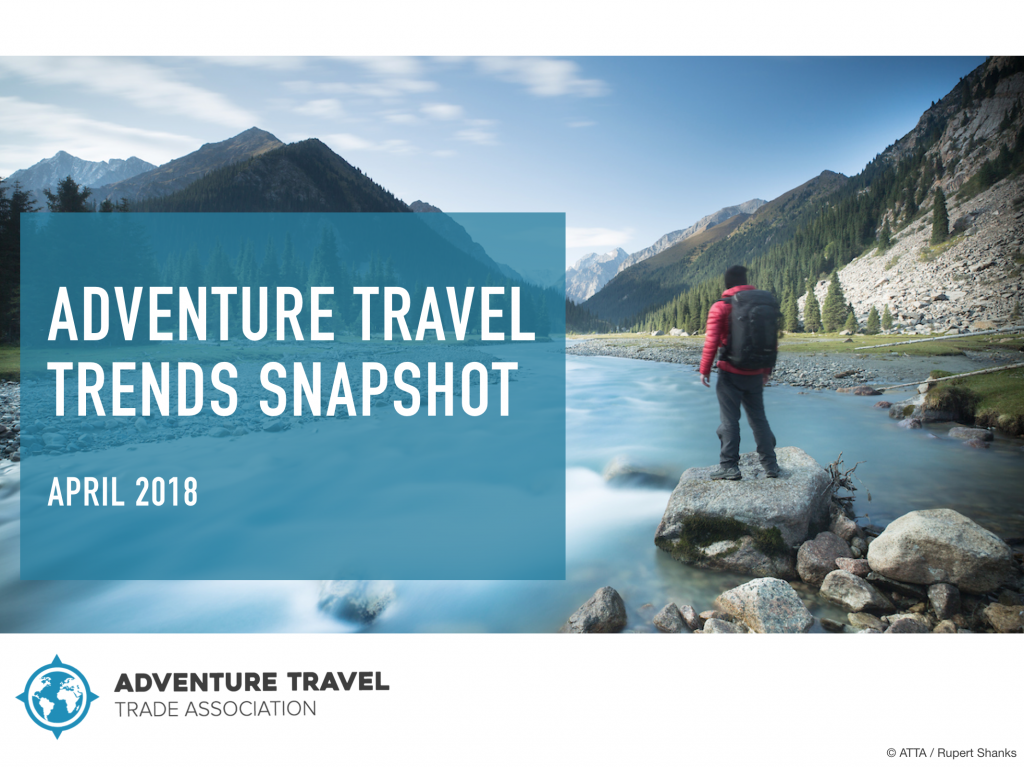In 2017, South America and the Mediterranean were hotspots for adventure travelers, but over the last several months, Eastern Europe and Southeast Asia have increasingly piqued travelers’ interest. This shift in the adventure travel industry is but one notable insight to surface in the 2018 Industry Snapshot Survey, the Adventure Travel Trade Association's (ATTA) annual summary of data collected from adventure travel operators. For more than a decade, the ATTA has conducted this survey, which provides information about the health, outlook, and characteristics of this dynamic industry.

Though the 2018 Travel Trends Report focuses on general trends within the travel industry and relates them to adventure travel, the Industry Snapshot shares specific perspectives of adventure travel businesses, providing up-to-date information regarding trending destinations, activities, and industry practices. Business owners often use this information as a benchmarking tool since the data is collected from anonymous respondents who share information about their operations and trends they are experiencing within the industry.
The majority of respondents (56 percent) characterize themselves as inbound operators (suppliers), while 26 percent are outbound tour operators (buyers), and 18 percent function as both inbound and outbound companies. Based on the 216 completed surveys, tour operators reported the global average age of their clients to be 49, an increase of two years from 2017. Customizable itineraries are the most popular trip type, followed by long haul/overseas travel, family friendly, environmentally sustainable, and solo travel. Hiking rises to the top as the single most popular activity, and this year’s average trip length is eight days. Fifty-one percent of businesses have an online booking system, and the majority of their guests continue to call or email companies directly rather than using online reservation options.
This year the Industry Snapshot introduces Eastern Europe and Southeast Asia among the “hot” list of destinations sought out by adventure travelers. These two new destinations replace South America and the Mediterranean while Scandinavia and Southern Africa remain popular.
Commenting on Eastern Europe, one local tour operator, Jack Delf, chairman of the Western Balkans Geotourism Network and owner of Black Mountain Ltd. said, “The attractions are here and the tourism businesses in the region are rapidly developing new and innovative ways for guests to experience local lifestyles and make genuine connections with the host communities. Active and adventure gastronomy, wine and rakija-making experiences, as well as music and dance activities, are now available in ways they were not previously.”
When considering factors responsible for increasing the popularity of certain destinations, one contributing factor is likely the growth in investment regional governments and foreign aid agencies have made to support their products and services within the adventure, active, and nature-based travel sectors. For example, over the last three years, the Eastern European region has engaged the ATTA in developmental programs including the ATTA’s inaugural AdventureNEXT in the Balkans, an event that drew trade partners and media to the region, putting this emerging destination on the adventure map; AdventureEDU, which provides training for governments, associations, and tour operators in creating, marketing, and delivering high-quality adventure travel experiences; and an AdventureWeek involving Macedonia, Kosovo, and Albania, in which the ATTA convened international media, operators, and specialized agents on a personalized tour, introducing them to local operators and suppliers.
“With this increased investment, adventure travelers are being exposed to lesser-known regions. Hiking, the most popular activity as reported by operators, is one of the greater Balkans’ strongest suits, but it has been mostly off the radar until now,” said Chris Doyle, the ATTA’s executive director for Europe. “For example, the ‘mega-mountaineering and hiking trail’ known as the Via Dinarica is a great option that crosses seven Balkan destinations. It deeply connects natural and cultural experiences throughout the Dinarica Alps, which holds important potential for responsible development in the region. Featuring such signature routes at ATTA events has helped attract global distinctions. For example, the Via Dinarica made such an impression on the then-editor of National Geographic Traveler during AdventureWeek that he later recognized it in the publication as one of the best destinations in the world.”
Another example of how increased investment eventually finds its way into the consumer mindset and tour operators’ catalogs can be found in adventure travelers’ growing interest in Southeast Asia. Governments are spending $323 USD billion on the region’s infrastructure projects, funding everything from airport expansion and improvement to high-speed rail and expressway creation.
“Adventure travelers have more and more interest in traveling to Southeast Asia,” said Phillippe Richard, co-founder of Easia Travel, which operates in Laos, Thailand, Myanmar, Vietnam, and Cambodia. “For all travelers staying from three-star to top luxury hotels, people tend to ask increasingly for days of adventure during their journeys. They use adventure activities to discover a place or connect with people in a different way than the classic FIT (fully independent traveler) visits. We believe so much in its bright future that we decided to launch a new organization named Easia Active with full teams dedicated to pure adventure travel.”
The Industry Snapshot is available to download from the ATTA. The report is free for all ATTA members and available for purchase for all other interested parties.
